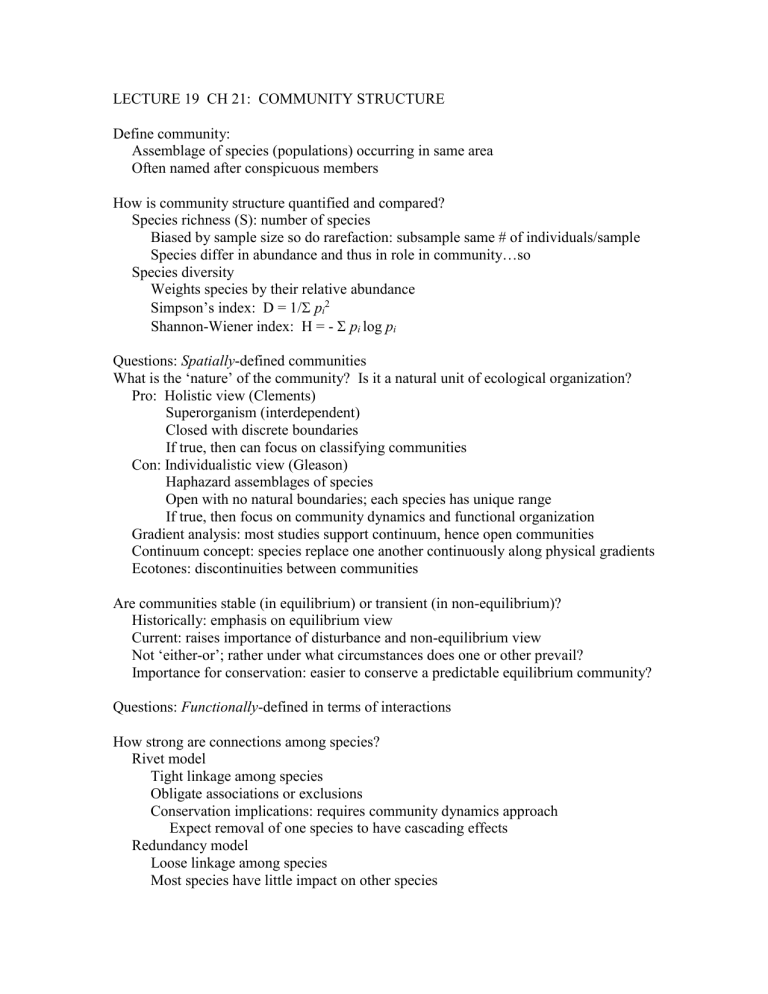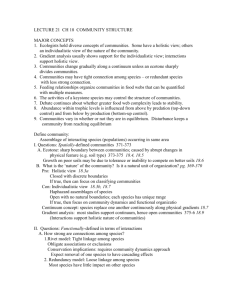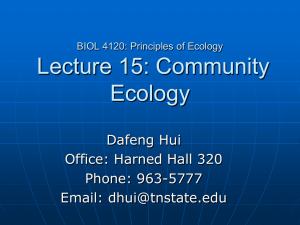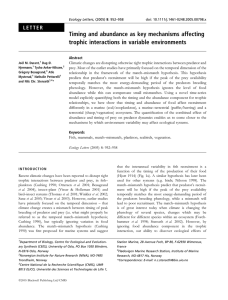19 Lecture Ch 21

LECTURE 19 CH 21: COMMUNITY STRUCTURE
Define community:
Assemblage of species (populations) occurring in same area
Often named after conspicuous members
How is community structure quantified and compared?
Species richness (S): number of species
Biased by sample size so do rarefaction: subsample same # of individuals/sample
Species differ in abundance and thus in role in community…so
Species diversity
Weights species by their relative abundance
Simpson’s index: D = 1/
p i
2
Shannon-Wiener index: H = -
p i log p i
Questions: Spatially -defined communities
What is the ‘nature’ of the community? Is it a natural unit of ecological organization?
Pro: Holistic view (Clements)
Superorganism (interdependent)
Closed with discrete boundaries
If true, then can focus on classifying communities
Con: Individualistic view (Gleason)
Haphazard assemblages of species
Open with no natural boundaries; each species has unique range
If true, then focus on community dynamics and functional organization
Gradient analysis: most studies support continuum, hence open communities
Continuum concept: species replace one another continuously along physical gradients
Ecotones: discontinuities between communities
Are communities stable (in equilibrium) or transient (in non-equilibrium)?
Historically: emphasis on equilibrium view
Current: raises importance of disturbance and non-equilibrium view
Not ‘either-or’; rather under what circumstances does one or other prevail?
Importance for conservation: easier to conserve a predictable equilibrium community?
Questions: Functionally -defined in terms of interactions
How strong are connections among species?
Rivet model
Tight linkage among species
Obligate associations or exclusions
Conservation implications: requires community dynamics approach
Expect removal of one species to have cascading effects
Redundancy model
Loose linkage among species
Most species have little impact on other species
Multiple species can play same ecological role
If remove one species, another takes over
Conservation implications: can focus on single-species dynamics
Keystone species = antithesis of redundancy
Food webs and community function
What changes with increased food web complexity?
Number of trophic levels
Number of guilds per trophic level
Number of interactions/specie (doesn’t change)
Connectance = # interactions/total possible = # interactions/[S(S-1)]
Linkage density = # interactions/ # species
Number of trophic levels
Theory: Does greater food web complexity contribute to community stability?
Pros: Alternative resources; less dependent on fluctuations in any one resource
Energy can take many routes; disrupt one pathway shunts more energy to
another
Cons: More links creates widespread, destablilizing time lags in pop. processes
What controls abundance within each trophic level?
Top-down control (= predation)
Bottom-up control (=nutrients, plant productivity, plant defense)
Trophic cascade: ripple effects from top level through multiple trophic levels
Indirect effects on lower levels; abundance alternates at each trophic level
What is the role of keystone species in communities?
Non-redundant species that maintains community stability and diversity
System-specific: Can be plant, herbivore, or predator











